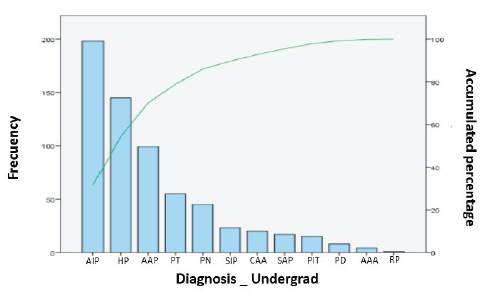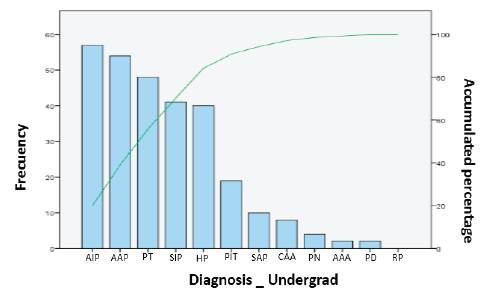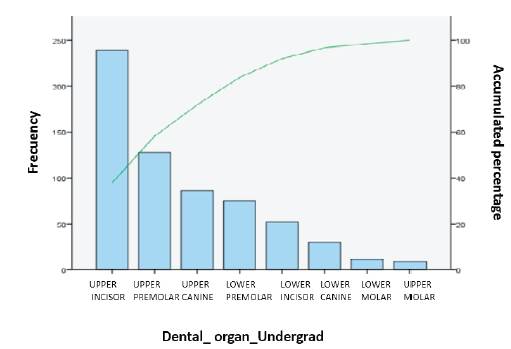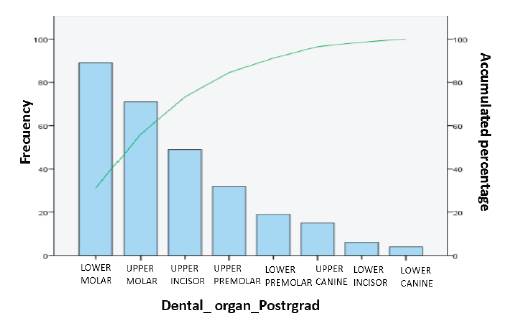INTRODUCTION
Pathologies of endodontic origin are the main cause of emergency care in dental practices, due to the painful symptoms that most of these have. Pulpal pathologies are those alterations or injuries caused in the pulp tissue that can advance towards the periapical area of the tooth, through the apical foramen caused by a periapical pathology 1.
The dental pulp is a delicate connective tissue that contains abundant blood vessels, lymphatics, nerve fibers and undifferentiated cells 2, the pulp is responsible for maintaining dentin vitality, conducting its sensitivity and supplying it with substances necessary for its repair. The dentin depends on the pulp tissue for its formation and maintenance, but in turn, it acts as a defense barrier for the pulp 3. Since it is prone to suffer injuries due to the existence of various etiologies for the appearance of endodontic diseases, such as mechanical, thermal, electrical and chemical irritants, traumatic injuries and periodontal problems 4.
Dental emergencies are a problem of high prevalence, recent data from the United States of America suggest that 22% of the general population presented orofacial pain in the last six months. The Chilean population presents a high damage to their oral health and the response to demands for dental treatment is made through emergency dental care. In Cuba, emergency care was concentrated in hospitals, while the majority of cases could be considered as mild, and be attended by primary health care (PHC), a situation that was also described in other countries 3.
Epidemiological studies report that dental caries is the most frequent etiological factor for the appearance of pulp disease, according to the depth and extension of this, anaerobic and Gram negative microorganisms are one of the most important causes that can affect the pulp 5.
In the studies carried out in Colombia, it was found that the National Oral Health Study IV (ENSAB IV) establishes that dental caries is the most prevalent dental disease in Colombians. It is important to keep in mind that people who are currently between the ages of 40 and 50 years are the most analyzed cohort in the four studies conducted in the country since 1995, due to the high incidence of caries. In this cohort of people, it would be expected to be able to control the progression of the carious process, through preventive actions and risk control, it would be achieved not only having less frequency of dental caries, but also preventing the progression of it, thus controlling pulp and periapical diseases 5.
Studies determined that the largest number of root canal treatments were performed in people aged 36 years old and the most predominant gender were females, because they have more time to attend for treatment, they found that the largest number of patients corresponded to students and housewives. 6
Many epidemiological studies of this type exist, carried out in other countries such as Cuba 7, Brazil 8 and Peru 6, but in Colombia there is little epidemiological information related to the prevalence of pulpal and periapical pathologies, since only one study exists, which was performed at the Universidad del Valle 5; In addition, there are no statistics in the literature on the epidemiology of endodontic pathologies in the School of Dentistry of the University of Cartagena; which is why the objective of this study is to establish the prevalence of pulp and periapical pathologies presented at the University of Cartagena and to relate these to other variables such as sex, age, etiology and the affected dental organ; which will favor and/or contribute to scientific, social and educational knowledge, as well as epidemiological surveillance according to the results obtained.
MATERIALS AND METHODS
A cross-sectional descriptive observational study was carried out, this type of study was described by Méndez in 1990. The population of the study consisted of patients who attended the School of Dentistry of the University of Cartagena for presenting any endodontic pathology in 2015. In this year 915 endodontic clinical records were filled, 630 corresponded to patients who attended the undergraduate program and 285 attending the postgraduate program. The inclusion criteria included: endodontic clinical records archived in the period between January and December of 2015. Records of non-archived and poorly completed endodontic clinical records were excluded.
A matrix table that contained the variables corresponding to the information collected from the clinical records filled out by the dentistry students of the University of Cartagena was developed. The variables were the following:
Age (less than 20 years, between 20-45 years and over 45 years), sex (female and male), dental organ (upper incisors, lower incisors, upper canines, lower canines, upper premolars, lower premolars, upper molars, lower molars), etiology (bacterial, traumatic, iatrogenic and pre-prosthetic), diagnosis (healthy pulp, reversible pulpitis, symptomatic irreversible pulpitis, asymptomatic irreversible pulpitis, progressive calcifying pulpal degeneration, pulpal necrosis, symptomatic apical periodontitis and asymptomatic apical periodontitis, acute and chronic apical abscess, previously treated tooth and previously initiated therapy).
As for the analysis and interpretation of the information, the data were included and organized in the Excel version for Windows 2007. The frequency tables were made with their respective graph.
According to the resolution008430 of 1993 of the Ministry of Social Protection of Colombia, this study is considered without risk; therefore no interventions or modification of the biological, physiological, psychological or social variables of the clinical records of study were carried out and the collection of data is confidential, so the identity of the patients will not be disclosed in order to protect their rights.
RESULTS
The age range with the highest representation was patients over 45 years of age with 71.7% and 55.7% in both undergraduate and postgraduate programs respectively; followed by the population of 20-45 years with 26.8% in undergraduate and 35.4% in postgraduate, the age range less presented were those under 19 years with a 1.42% in undergraduate and 8.7% in postgraduate.
In terms of gender, the predominant sex were females with 68% in undergraduate and 70.1% in postgraduate. The most affected dental organs were the upper anterior and upper premolars with 37.9% and 20.3% respectively in undergraduate; and as for the postgraduate program, the lower molars were the most affected with a 31.2%, followed by the upper molars, with a 24.9% (Figure 1 and 2).
The bacterial etiology prevailed in 54.6%, followed by pre-prosthetics with a 23.9%, while the least prevalent etiologies were traumatic and iatrogenic with a 13.49% and 7.93% respectively in undergraduate; in the postgraduate program it was not possible to determine this variable because in the clinical records this is not specified. The most prevalent endodontic diagnosis was asymptomatic irreversible pulpitis with 31.4% in undergraduate and 20% in postgraduate; followed by healthy pulp with 23% undergraduate; and asymptomatic apical periodontitis with 18.9% in postgraduate (Figure 3 and 4).

Endodontic diagnosis: HP: Healthy Pulp; RP: Reversible Pulpitis; SIP: Symptomatic Irreversible Pulpitis; AIP: Asymptomatic Irreversible Pulpitis; PD: Pulp Degeneration; PN: Pulp Necrosis; SAP: Symptomatic Apical Periodontitis; AAP: Asymptomatic Apical Periodontitis; AAA: Acute Apical Abscess; CAA: Chronic Apical Abscess; PT: previously treated; PIT: Previously Initiated Therapy.
Figure 3 Prevalence of endodontic pathologies (undergraduate)

Endodontic diagnosis: HP: Healthy Pulp; RP: Reversible Pulpitis; SIP: Symptomatic Irreversible Pulpitis; AIP: Asymptomatic Irreversible Pulpitis; PD: Pulp Degeneration; PN: Pulp Necrosis; SAP: Symptomatic Apical Periodontitis; AAP: Asymptomatic Apical Periodontitis; AAA: Acute Apical Abscess; CAA: Chronic Apical Abscess; PT: previously treated; PIT: Previously Initiated Therapy.
Figure 4 Prevalence of endodontic pathologies (postgraduate)
DISCUSSION
The main limitation presented was the poor completion and lack of important data in the medical records. So we proceeded to ask students not to leave blank spaces in these stories.
The age group mostly found in the study were patients older than 45 years, these results are similar to Gómez and García's 4 in the study Comportamiento De Las Patologías Pulpares Y Periapicales En Los Pacientes Mayores De 19 Años, where they determined that the prevalent age was between 46 and 52 years old with a 52.6%. These results are not similar to those reported by Cigales et al 9 and by Gonzáles et al 6 because most of the endo-dontic treatments were performed in the age ranges between 20-34 years and 23-35 years respectively with a 30.1%.
Regarding gender, the sex that attended the School of Dentistry of the University of Cartagena the most were females on both undergraduate and postgraduate programs. These results coincide with those of various authors, and they can be compared with those obtained by Gaviria et al 5 in an epidemiological study conducted at the School of Dentistry of the Universidad del Valle in 2012, where the female sex had a higher prevalence of pulp lesions with a 61.9%. Likewise, in the study called Frecuencia De Diagnósticos Y Tratamientos Pulpares Según Indicadores De La Demanda Realizados En Una Clínica Dental Universitaria6 where the highest percentage of root canal treatments were found in female patients with a 66.3%. In the study by Graña et al in 2009, the female sex was the most affected with a 60%. On the contrary, results obtained in the study performed by Parejo Madén et al2 in 2014, differ from the present study, since the male sex was the most predominant, with a 69.1%.
The dental organs with a greater prevalence of pulp and/or periapical disease were the upper incisors in the undergraduate program. The obtained results were very similar to those of Gonzáles et al6 in 2005 where the greater percentage of affected teeth were upper incisors with a 50.2%. As for the molars, which were the most affected dental organs in the postgraduate program, it is basically due to the fact that, if endodontic treatment is required in these teeth, they are rarely treated in undergraduate clinics, so in most cases these are sent directly to the endodontics postgraduate. The results obtained by Gaviria et al5 can be compared with those found in this study, since the teeth most affected were the molars in general with 35%; as in the study by Montoro et al11 in 2012 with a percentage of 38.2%.
The most recurrent etiology was bacterial, these results can be compared with the studies carried out by the authors Parejo et al2; and Gómez and García 4 in 2009, where it was determined that the etiological factor that most affected the appearance of pulp and periapical pathologies was dental caries, that is, bacterial etiology with 46.9% and 90.6% respectively.
The most frequent pulp diagnosis in patients who attended the School of Dentistry was the asymptomatic irreversible pulpitis both in undergraduate and postgraduate programs. In the study conducted by Gonzáles et al6 the most prevalent pathology was symptomatic irreversible pulpitis, which differs with the results of the present study, due to the fact that in the School of Dentistry of the University of Cartagena, the majority of patients who come with spontaneous pain, are treated immediately in the emergency clinic. While the second most frequent diagnosis made was that of healthy pulp with 27.4%, keeping a certain similarity with the present study. The second most frequent diagnosis in the postgraduate program was asymptomatic apical periodontitis, which is similar to the results obtained by León et al12 in 2011 in his study called Frecuencia De Periodontitis Apical En Tratamientos Endodónticos De Pregrado which showed that the most presented diagnosis was asymptomatic apical periodontitis with a 54.6%. These results differ considerably from the results reported by Viltres and Cuevas 3 in which pulp necrosis predominated in 51 patients (49.51%) which affected an age range of 19-34 years.
CONCLUSIONS
Through the present study it can be concluded that endodontic pathologies majorly affected the female population over 45 years old; the most frequent etiology was bacterial and the most prevalent pulp pathology was asymptomatic irreversible pulpitis, affecting mostly both upper incisors and lower molars.
















